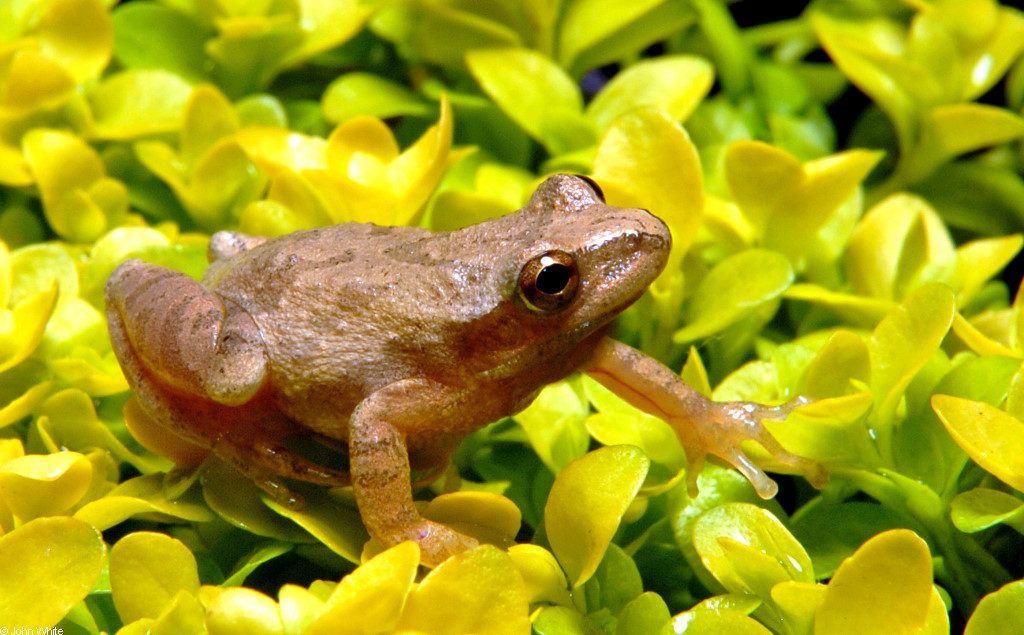April 15, 2018
April hath put a spirit of youth in everything.
—William Shakespeare
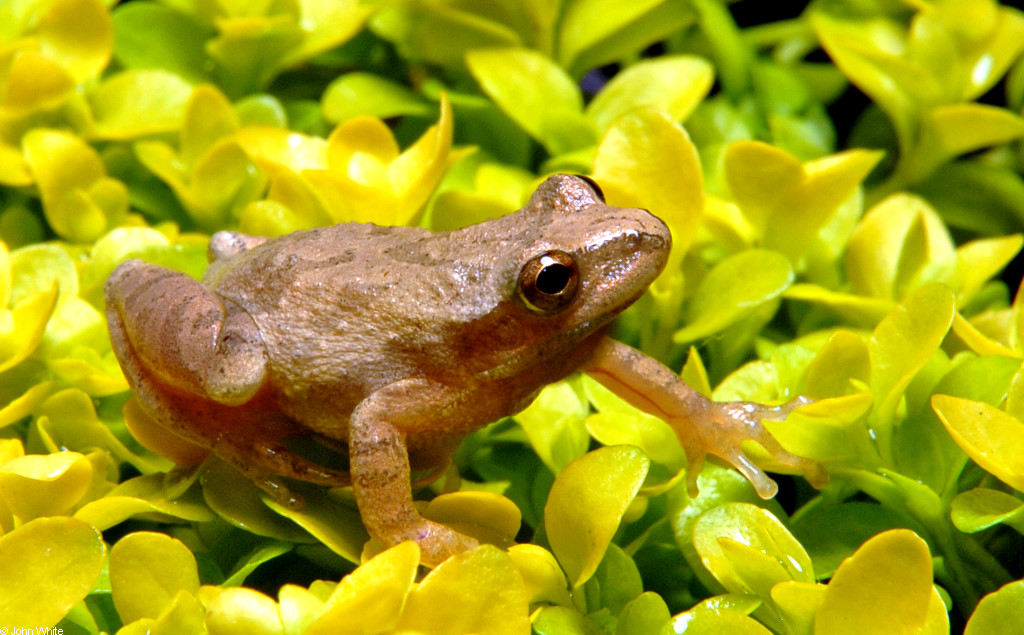 Our Kimberton LifeWays students celebrated their commencement from the LifeWays Early Childhood Training a few weeks ago, and the spring peepers were out in full force during their final week of class! These tiny frogs awaken from their winter slumber when the bogs and lowlands fill with water, and they produce a cacophony of shrill chirps to attract their spring mates. Their cheerful heralding of Spring gladdens our hearts and urges us to awaken from our own winter stillness. (Click here to listen to the spring peepers.) The songs of the spring peepers and the birds call to us, “Wake up! Spring is here!”
Our Kimberton LifeWays students celebrated their commencement from the LifeWays Early Childhood Training a few weeks ago, and the spring peepers were out in full force during their final week of class! These tiny frogs awaken from their winter slumber when the bogs and lowlands fill with water, and they produce a cacophony of shrill chirps to attract their spring mates. Their cheerful heralding of Spring gladdens our hearts and urges us to awaken from our own winter stillness. (Click here to listen to the spring peepers.) The songs of the spring peepers and the birds call to us, “Wake up! Spring is here!”
Blessings on your week!

Mary O’Connell, Your Living Arts Weekly blog editor
Social Awareness
What is awakening in your heart this week? Take a moment to read John O’Donohue’s beautiful words below and reflect on the following:
In what ways can you awaken to the “secret symmetry of your soul”?
To your loved ones, friends and colleagues?
To your community?

John O’Donohue ~ “May You Awaken”
May you awaken to the mystery of being here
and enter the quiet immensity of your own presence.
May you have joy and peace in the temple of your senses.
May you receive great encouragement when new frontiers beckon.
May you respond to the call of your gift and find the courage to follow its path.
May the flame of anger free you from falsity.
May warmth of heart keep your presence aflame and may anxiety never linger about you.
May your outer dignity mirror an inner dignity of soul.
May you take time to celebrate the quiet miracles that seek no attention.
May you be consoled in the secret symmetry of your soul.
May you experience each day as a sacred gift woven around the heart of wonder.
Creative Exploration
From Marianne Alsop, director of the California Coast LifeWays training. Marianne has been involved in Waldorf education for over 40 years as a mother, early childhood teacher and facilitator of Waldorf parenting groups.
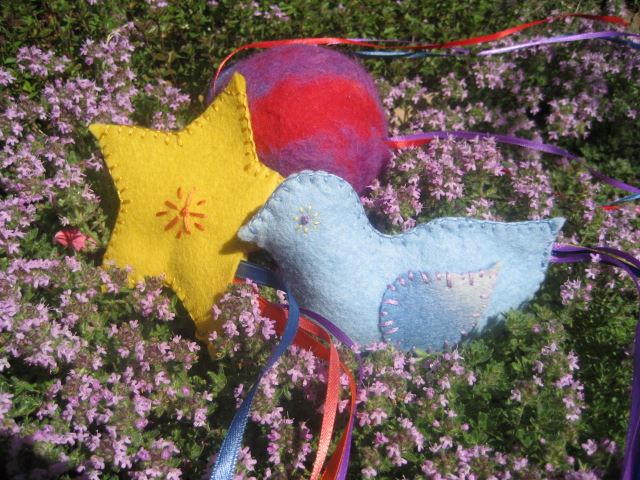
Beanbags (for children ages 2+)
Materials needed:
Wool or wool blend felt in the colors of your choice.
Embroidery floss in colors to match felt.
Embroidery needle.
Rice, millet or small beans
Multi colored ribbons, each 12” to 20” long in your choice of colors
Here’s how to make them:
Download and print a copy of the pattern here. (This is a free download.)
Cut out the pattern on the felt.
For the bird cut out 2 wings as well and sew these on to the bird before sewing the two bird pieces together.
Using the blanket stitch, sew around the beanbag, leaving at least a ¾” opening. On the star, bird, butterfly, leave the opening in the back/rear of the animal.
The seam should show.
Fill your beanbag with small beans or rice. Before sewing the opening closed, insert the multicolored ribbons and then stitch closed using a running, or plain sewing stitch. Make sure this opening is closed so your beans and ribbons do not fall out.
Add eyes to the bird and decorations to the star.
Two little blackbirds sitting on the wall
One named Peter, the other named Paul.
Fly away, Peter! Fly away, Paul!
Come back, Peter! Come back, Paul!
Two little blackbirds from LifeWays North America on Vimeo.
Special thanks to LifeWays North America’s Executive Director, Cynthia Aldinger, for this sweet interpretation of a favorite nursery rhyme.
Little Catbird Finds Her Voice
This story comes to us from Pamela Perkins, who has worked with and for children in various capacities since 1970. A former Waldorf teacher, LifeWays graduate and home provider, she now delights in being with her five granddaughters, plus creating magical needle-felted puppet stories and writing gentle tales to nurture young and old. She lives in the Upper Valley of Vermont, and is working on her new writing project Silver Seedlings – Nurturing Tales for the Young and Young at Heart.

Little Catbird grew up in a bush right on the edge of a forest of tall pine trees, sturdy oaks and willowy grey birches. Her best friends, who lived in the next tree, were a family of blue jays. Every morning she awoke and heard them calling loudly to her: “Squawk! Screech! Squawk!” This is how blue jays talk. “Squawk! Screech! Squawk!” Little Catbird loudly answered in return. This is how she had learned to talk.
One fine bright morning she flew out of her nest and off into the blue, blue sky. She flew, and she flew. What a wonderful feeling, to flit and float and flutter through the air. When she paused to rest, she found herself in a part of the woods she had never seen. At first, she felt lost and unsure, but gradually, as she looked around, she saw so many interesting things that she began to enjoy herself.
The trees stood further apart and there were many new kinds to explore. They bordered small open meadows filled with tall grasses and wildflowers. Something else felt very different here, but at first, she did not know what this was. After a while, she realized that it was quieter – no squawking! It was so quiet she could hear the babbling of a tiny stream as it splashed and spilled over the stones. It was so quiet she could hear the bees buzzing going from flower to flower. It was so quiet, she even heard a butterfly whisper as it fluttered by her, “Welcome, Little Catbird!”
Soon Little Catbird made new friends. She loved hearing their chirps and twitters, their whistles and trills. She loved the tinkling sound of the running water, the rippling of rain, and the wind-whispers amongst the leaves of the trees. By day, she heard the hum of insects busy with their work, and by night, the singing of the little crickets and frogs. Little Catbird soon discovered that she could sing and chirp, whistle and trill, just like each of her friends – and even make a liquid lilting rather like the little stream’s voice. This made both her and her friends happy!
She loved to flit from branch to branch and play hide-and–seek among the bushes and briars and grapevines that tangled in and between the trees. Soon the summer sun ripened berries and fruits of all kinds; every day she found delicious bugs for her breakfast. As the nights and days grew cooler, she prepared for her journey to the warmer lands in the South, where she would stay until King Winter had returned to his frosty kingdom in the far North. But before she left, she made a visit to her friends the blue jays, traveling back to the pine and birch trees where she had grown up. She enjoyed seeing them, but oh my! they certainly were loud and squawky! She knew that although they would always be her friends, when she returned again in the Springtime, she would make her own nest in the bushes and briars and grapevines where it was not so noisy, and she could hear the many sounds of the forest and sing these voices back to all of her friends in her own special voice.
Practical Activity
A springtime recipe for awakening
From Pamela Perkins
Whole foods provide us with the forces we need to help us become whole human beings. A nutritious breakfast affords an obvious starting point. Here is one simple recipe idea which children can readily learn to help prepare. Muesli is versatile and offers a welcome alternative and transition from the hot cereals of winter months.
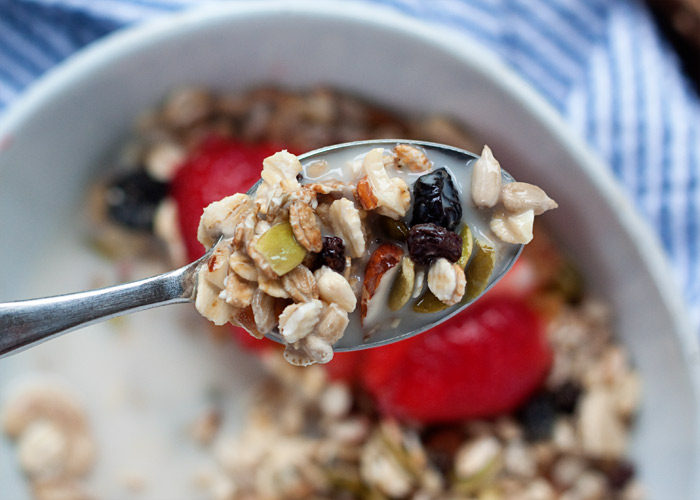
Fresh Flake Muesli
(Child Tested Recipe)
Into a medium-size mixing bowl combine these ingredients:
- One half cup of organic rolled oats per person for hearty eaters. (1/3 cup may suffice for more modest appetites, or 1 / 4 cup if toast, cornbread or muffins are also served. Adjust this proportion to your individual needs).
- Add I/ 4 tsp. of both ground allspice and coriander for each serving. Cinnamon or other favorite spices may be substituted. Give the novice older child chef definite suggestions until they acquire a sense for complimentary spice combinations.
- Next add a pinch of salt and stir – wooden spoons make soothing sounds early in the morning.
- Now cut up fresh seasonal fruit into small bite sized pieces or use whole frozen berries (organic or eco-grown if possible) – about 1 cup per person – and add to the oat mixture. Do not stir yet.
- In another smaller bowl measure 1/4 cup of liquid per person – such as apple juice, milk, yogurt, or a non-dairy equivalent, plus 1/4 tsp. pure vanilla extract. Mix together, then gently stir into the oat-fruit bowl. Adjust liquid if necessary: the muesli should be moist, but not soggy.
- Put extra yogurt, rice milk, etc. on the table, along with honey or maple syrup.
- Set the table, call everyone together, serve and enjoy together!
Optional: finely chopped nuts, about 2 Tbs. per person; finely grated lemon rind, about 1/4 tsp. per person, sunflower seeds, fresh coconut. Once the basic proportions are mastered, let imagination take wing. With the dramatic increase in dietary sensitivities and allergies, gluten free oats might be a wise choice, as well as keeping the recipe simple and basic, without any extras.
Nurturing Care
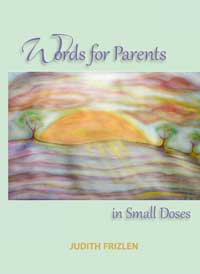
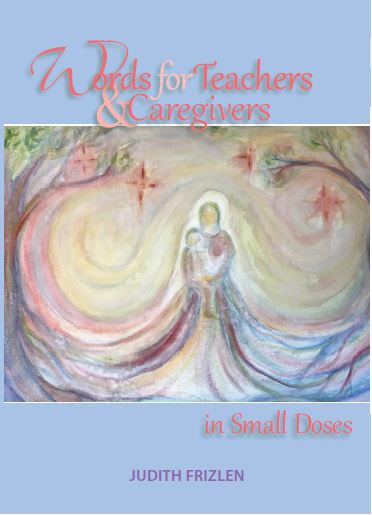
Awakening our own inner life is vital to our effectiveness as parents and teachers/caregivers. Judith Frizlen has written two wonderful reflective guides to help you along this path. Words for Parents in Small Doses and Words for Teachers and Caregivers in Small Doses offer simple, yet profound weekly reflections to help you align your own work and self-development as a parent or teacher/caregiver with the subtle rhythms of the natural world. Nurture yourself and the little ones in your life with this simple weekly practice of self reflection and renewal.
